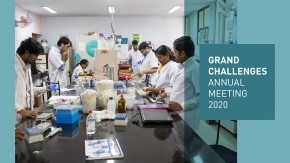
In early 2003 I found myself in a small unmarked office in Washington D.C. with Harold Varmus, Elias Zerhouni, Rick Klausner, Patty Stonesifer, and Elke Jordan. We were starting to design the original Grand Challenges in Global Health initiative in advance of Bill Gates' announcement of the initiative at Davos that year. One of the great privileges of my life has been to be involved since in this incredible movement.
Looking back, it is clear to me that the Grand Challenges in Global Health initiative was a watershed and it changed the course of global health. Before 2003, there was skepticism that world-class discovery science had a legitimate role, despite the fact that some of the greatest scientific advances, such as vaccines, were the bulwark of the public health approach to global health. The Grand Challenges in Global Health initiative, has, more than any other single intervention, established the legitimacy, indeed the necessity, of science and innovation in global health.
The Grand Challenges in Global Health initiative has had many successes, and some of these are described in the companion blog by Steve Buchsbaum. It is impossible to innovate without failure, and the Grand Challenges model has also had its share of failures and many lessons learned. Finally, the Grand Challenges initiative has delivered one great surprise.
Our experience over the past decade has led to a set of principles that underlie the Grand Challenges approach, as follows:
1. Strategic and well-articulated Grand Challenges serve both to focus research and development efforts and to capture the imagination of and engage the world's best researchers and innovators. The Grand Challenges model focuses on seeking solutions to well-defined problems. The initiative brings these problems to the attention of relevant communities of solvers, both individuals and organizations, and invites creative and forward-thinking approaches to address issues that, if solved, can dramatically improve the world we live in.
2. Projects are selected based on public and transparent calls for proposals seeking the best ideas. The Grand Challenges programs do not purport to know the solutions to the world's most pressing development issues - but they are willing to take risks and invest to create new solutions. The Grand Challenges model aims to engage new solvers with fresh ideas.
3. Funders, innovators and other stakeholders actively collaborate to accelerate progress and promote advances to ensure they serve those most in need. The public, private, academic and nonprofit sectors must work together to accelerate and scale up innovations that can improve the lives of those most in need.
4. Projects are selected not only for scientific excellence, but also for the likelihood that they will achieve the desired scale and impact. Successful applicants present projects that, when proven successful through the collection of rigorous evidence, have the potential to serve those most in need. Investing in scientific innovation - as well as in the business and social innovation needed to increase impact at scale - will help ensure that these efforts have the greatest possible impact in terms of lives saved or improved.
5. Researchers and innovators work to ensure that the fruits of their projects are accessible and available to those most in need. Fostering ties to industry, either by helping bridge the private and public sectors or by directly funding a company, can create sustainable enterprises or reduce the time from discovery to development, production and impact. Key to these is developing global access strategies to ensure that those most in need benefit from new solutions.
There have been significant lessons learned along the way. These include:
- The original Grand Challenges in Global Health offered up to $20M for all grants. We have learned that a one size fits all approach is not wise and that we need to more carefully craft the challenge with a careful start of $100K for proof of concept with clear stage gates for scaling. This lesson informed the launch of the Gates Foundation's Grand Challenges Explorations program and Grand Challenges Canada's Stars in Global Health.
- Need for a greater focus to identify innovators from the developing countries who experience the challenges themselves. Those innovators had a better sense of the local conditions that influence successful scaling and sustainability including affordability, distribution channels, local cultural norms and so on.
- Need to better integrate science and technology innovation with social and business innovation. As the Grand Challenges evolved from a framing in terms of technology alone (e.g. about half the original grand challenges were focused on vaccines) to a framing focused on end beneficiaries like women, newborns, children and girls, it became clear that stimulating innovation in social, business and financial processes, often in combination with each other and with technology, could yield significant impact. At Grand Challenges Canada we call this 'integrated innovation.'
Finally, there has been one great surprise – completely unanticipated by anyone as far as I can tell: the spread of the Grand Challenges around the world.
In 2008, Canada became the first country to propose a Grand Challenges approach in its development assistance, which resulted in the launch in 2010 of Grand Challenges Canada. Next, USAID launched its Grand Challenges for Development initiative which demonstrates that the approach can be applied to a wide range of topics spanning health, agriculture, energy, education and even governance and conflict. Norway, Sweden and the UK joined in the movement through Saving Lives at Birth and other Grand Challenges, the Global Development Lab, and the Global Innovation Fund. India and Brazil launched their own Grand Challenges initiatives. Just this past year, Israel, South Africa, and Peru have launched Grand Challenges initiatives. The ASEAN region is also considering launching its own Grand Challenges.
Ignited by Bill Gates' spark a decade ago, Grand Challenges has spread to become a global movement which continues to spread. The challenges we face in the world are too large to be solved by any one organization or country alone. Grand Challenges provides a platform where different organizations - public and private, North and South, funders and innovators – can work together in partnership to solve global challenges. At its core, Grand Challenges is about the global governance of innovative solutions with impact.
An immediate opportunity that can take advantage of this approach is the post-2015 sustainable development goals. These will be finalized at the UN General Assembly in September 2015 and guide action for 15 years through 2030. It is widely recognized now that more emphasis has been placed to date on strategy development than on strategy execution in the development of these goals. Discussion is increasingly turning to so-called means of implementation. There is no better platform to solve the world's challenges using innovation than Grand Challenges and its partners.



